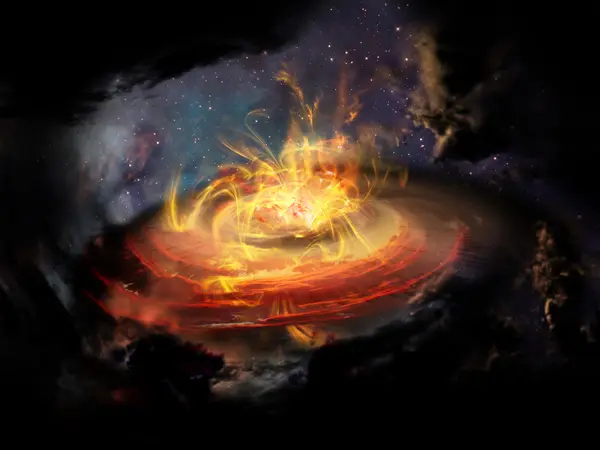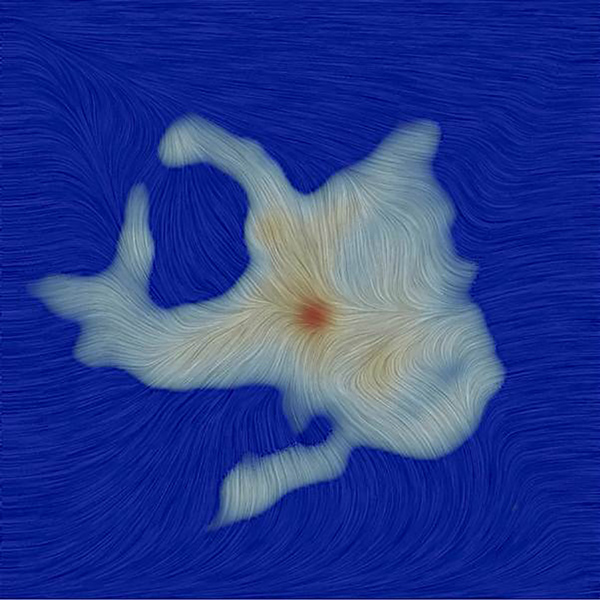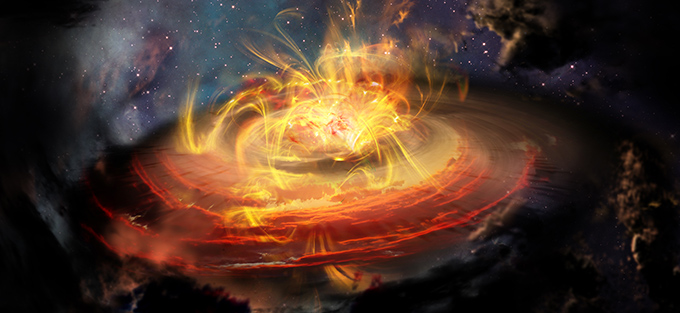Chaotically Magnetized Cloud Is No Place to Build a Star, or Is It?
14 June, 2017 / Read time: 4 minutes
ALMA Kids PublicationFor decades, scientists believed that the magnetic field lines around a forming star were extremely powerful and orderly, warping only under extreme force and at great distance from the nascent star.
Now, a team of astronomers using the Atacama Large Millimeter/submillimeter Array (ALMA) has discovered a weak and wildly disorganized magnetic field strikingly near a newly emerging protostar. These observations suggest that the impact of magnetic fields on star formation is more complex than previously thought.
The researchers used ALMA to map the surprisingly disorganized magnetic field surrounding a young protostar dubbed Ser-emb 8, which resides about 1400 light-years away in the Serpens star-forming region. These new observations are the most sensitive ever made of the small-scale magnetic field suffusing the region surrounding a young forming star. They also provide important insights into the formation of low-mass stars like own sun.
Previous observations with other telescopes have confirmed that magnetic fields surrounding some young protostars form a classic “hourglass” shape – a hallmark of a strong magnetic field – that starts near the protostar and extends many light-years into the surrounding molecular cloud.

“Before now, we didn’t know if all stars formed in regions that were controlled by strong magnetic fields. Using ALMA, we found our answer,” said Charles L. H. “Chat” Hull, an astronomer and NRAO Jansky Fellow at the Harvard-Smithsonian Center for Astrophysics (CfA) in Cambridge, Mass., and lead author on a paper appearing in the Astrophysical Journal Letters. “We can now study magnetic fields in star-forming clouds from the broadest of scales all the way down to the forming star itself. This is exciting because it may mean stars can emerge from a wider range of conditions than we once thought.”
ALMA is able to study magnetic fields at the small scales inside star-forming clumps by mapping the polarization of light emitted by dust grains that have aligned themselves with the magnetic field.

By comparing the structure of the magnetic field in the observations with cutting-edge supercomputer simulations on multiple size scales, the astronomers gained important insights into the earliest stages of magnetized star formation. The simulations – which extend from a relatively nearby 140 astronomical units from the protostar (about 4 times the distance from the sun to Pluto) to as far out as 17 light-years – were performed by CfA astronomers Philip Mocz and Blakesley Burkhart, who are coauthors on the paper.
In the case of Ser-emb 8, the astronomers believe they have captured the original magnetic field around the protostar “red handed,” before outflowing material from the star could erase the pristine signature of the magnetic field in the surrounding molecular cloud, noted Mocz.
“Our observations show that the importance of the magnetic field in star formation can vary widely from star to star,” concluded Hull. “This protostar seems to have formed in a weakly magnetized environment dominated by turbulence, while previous observations show sources that clearly formed in strongly magnetized environments. Future studies will reveal how common each scenario is.”
Additional information
This research was presented in a paper titled “Unveiling the Role of the Magnetic Field at the Smallest Scales of Star Formation”, by C. Hull et al., appearing in the Astrophysical Journal Letters.
The Atacama Large Millimeter/submillimeter Array (ALMA), an international astronomy facility, is a partnership of the European Organisation for Astronomical Research in the Southern Hemisphere (ESO), the U.S. National Science Foundation (NSF) and the National Institutes of Natural Sciences (NINS) of Japan in cooperation with the Republic of Chile. ALMA is funded by ESO on behalf of its Member States, by NSF in cooperation with the National Research Council of Canada (NRC) and the Ministry of Science and Technology (MOST) in Taiwan and by NINS in cooperation with the Academia Sinica (AS) in Taiwan and the Korea Astronomy and Space Science Institute (KASI).
ALMA construction and operations are led by ESO on behalf of its Member States; by the National Radio Astronomy Observatory (NRAO), managed by Associated Universities, Inc. (AUI), on behalf of North America; and by the National Astronomical Observatory of Japan (NAOJ) on behalf of East Asia. The Joint ALMA Observatory (JAO) provides the unified leadership and management of the construction, commissioning and operation of ALMA.
Contacts
-
Nicolás Lira
Education and Public Outreach Coordinator
Joint ALMA Observatory, Santiago - Chile
Phone: +56 2 2467 6519
Cel: +56 9 9445 7726
Email: [email protected]
-
Charles E. Blue
Public Information Officer
National Radio Astronomy Observatory Charlottesville, Virginia - USA
Phone: +1 434 296 0314
Cel: +1 202 236 6324
Email: [email protected]
-
Masaaki Hiramatsu
Education and Public Outreach Officer, NAOJ Chile
Observatory, Tokyo - Japan
Phone: +81 422 34 3630
Email: [email protected]
-
Richard Hook
Public Information Officer, ESO
Garching bei München, Germany
Phone: +49 89 3200 6655
Cel: +49 151 1537 3591
Email: [email protected]

